Tesco: Management and Organizational Analysis using Various Models
VerifiedAdded on 2023/06/14
|30
|9216
|378
Report
AI Summary
This report provides a comprehensive management and organizational analysis of Tesco, a leading supermarket chain. It begins with an overview of Tesco's structure, history, and market presence, highlighting its diverse store formats and international expansion. The analysis then delves into various organizational models, including Mintzberg's Configurations, Morgan's Metaphor Model, and Systems Theory, to understand Tesco's operational dynamics and culture. Management approaches are examined through Quinn's Competing Values Framework, Hofstede's cultural dimensions, and Senge's Five Disciplines, evaluating Tesco's leadership, learning capabilities, and cultural adaptation. The report concludes with recommendations for improvement, focusing on balancing theoretical frameworks with practical implementation to enhance organizational performance and address contemporary challenges.
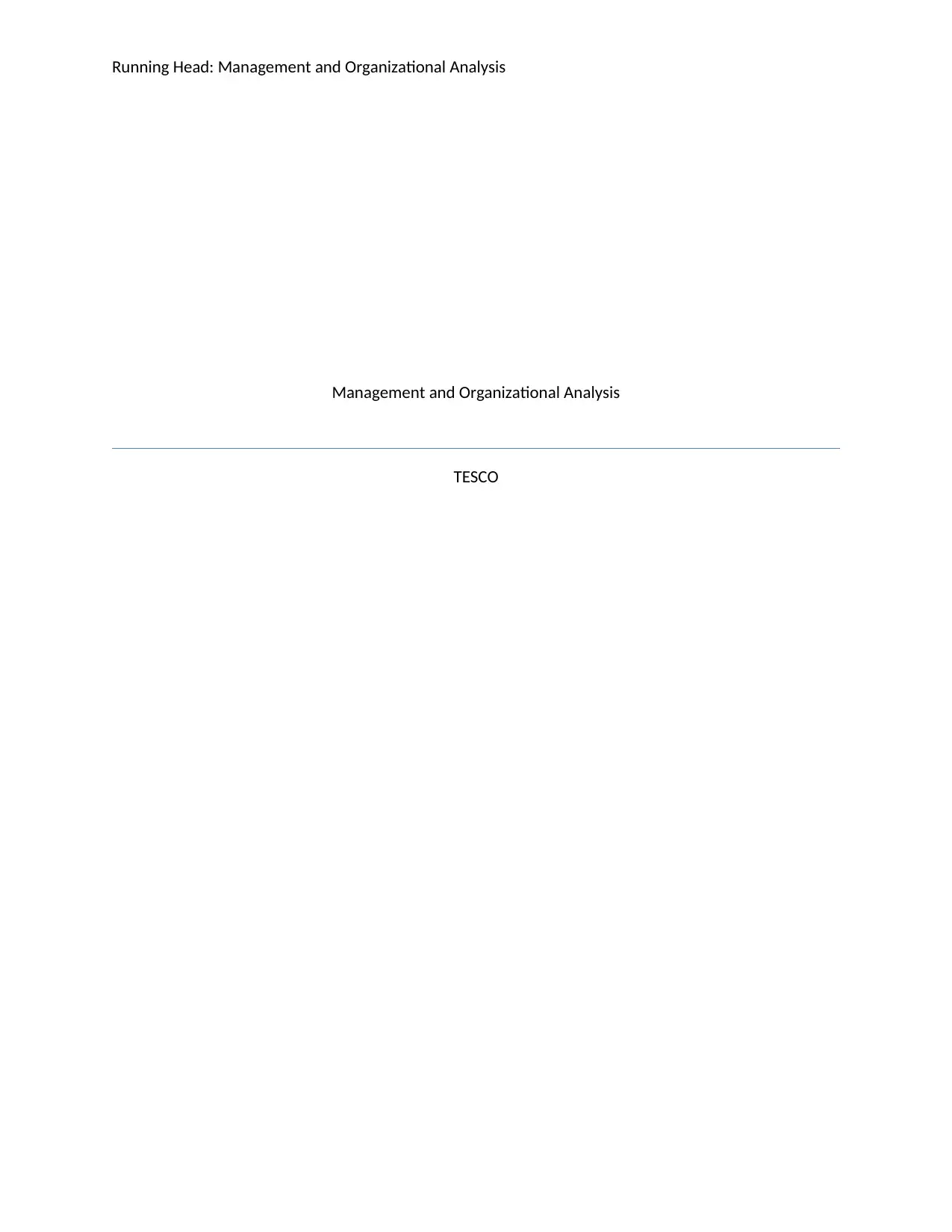
Running Head: Management and Organizational Analysis
Management and Organizational Analysis
TESCO
Management and Organizational Analysis
TESCO
Paraphrase This Document
Need a fresh take? Get an instant paraphrase of this document with our AI Paraphraser

Management and Organizational Analysis 1
Contents
Introduction.................................................................................................................................................2
Brief Overview.............................................................................................................................................2
Structure of Tesco.......................................................................................................................................3
Mintzberg’s Configurations.........................................................................................................................3
Morgan’s Metaphor Model.........................................................................................................................5
System Theory.............................................................................................................................................6
Management Approaches...........................................................................................................................7
Competing Value Framework......................................................................................................................8
Managing Across Cultures.........................................................................................................................10
Senge’s Five Disciplines.............................................................................................................................11
Theory v/s Practice and Strengths and Weaknesses.................................................................................12
Recommendations.....................................................................................................................................14
Conclusion.................................................................................................................................................15
References.................................................................................................................................................16
Appendix...................................................................................................................................................22
Multifactor Leadership Questionnaire...................................................................................................22
Organizational Audit..............................................................................................................................24
Contents
Introduction.................................................................................................................................................2
Brief Overview.............................................................................................................................................2
Structure of Tesco.......................................................................................................................................3
Mintzberg’s Configurations.........................................................................................................................3
Morgan’s Metaphor Model.........................................................................................................................5
System Theory.............................................................................................................................................6
Management Approaches...........................................................................................................................7
Competing Value Framework......................................................................................................................8
Managing Across Cultures.........................................................................................................................10
Senge’s Five Disciplines.............................................................................................................................11
Theory v/s Practice and Strengths and Weaknesses.................................................................................12
Recommendations.....................................................................................................................................14
Conclusion.................................................................................................................................................15
References.................................................................................................................................................16
Appendix...................................................................................................................................................22
Multifactor Leadership Questionnaire...................................................................................................22
Organizational Audit..............................................................................................................................24
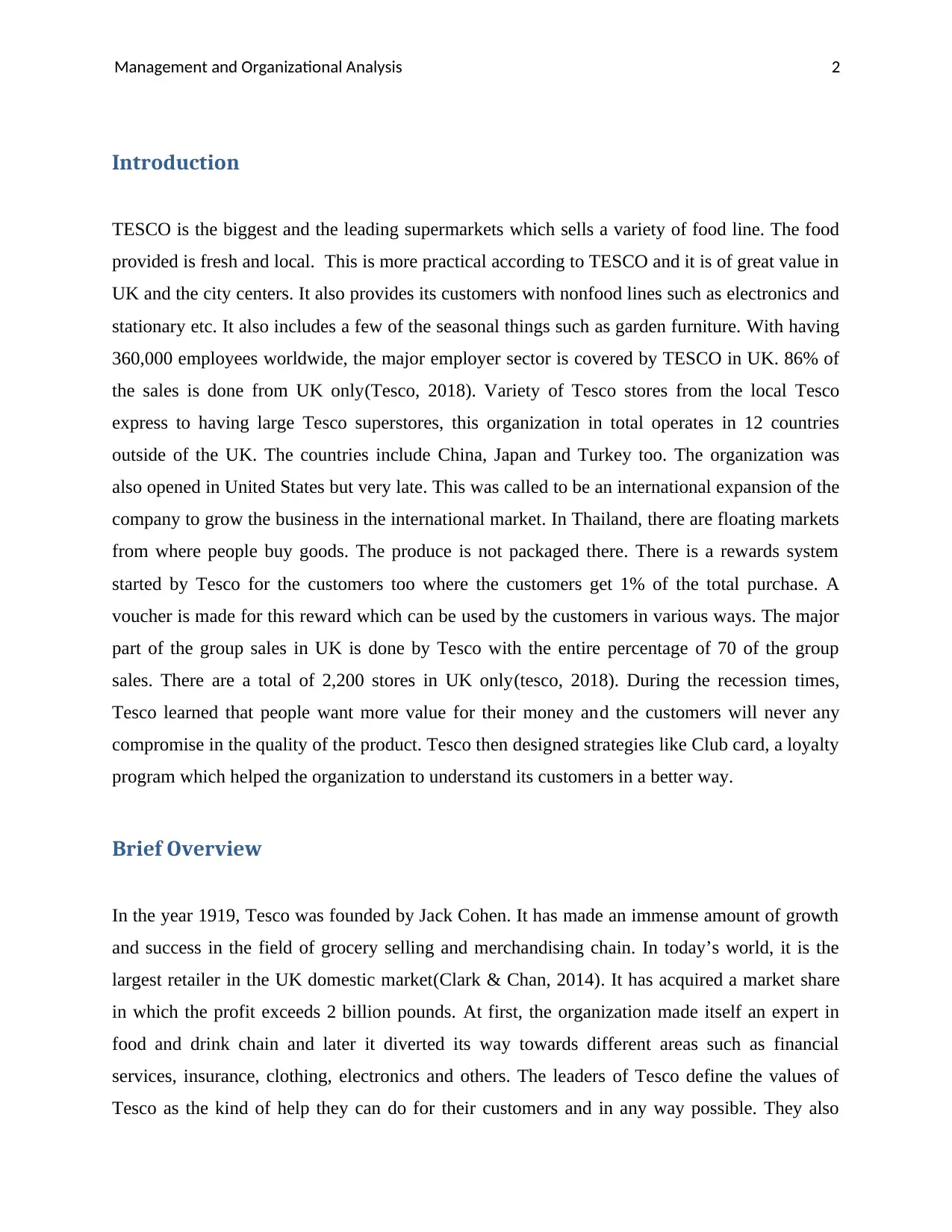
Management and Organizational Analysis 2
Introduction
TESCO is the biggest and the leading supermarkets which sells a variety of food line. The food
provided is fresh and local. This is more practical according to TESCO and it is of great value in
UK and the city centers. It also provides its customers with nonfood lines such as electronics and
stationary etc. It also includes a few of the seasonal things such as garden furniture. With having
360,000 employees worldwide, the major employer sector is covered by TESCO in UK. 86% of
the sales is done from UK only(Tesco, 2018). Variety of Tesco stores from the local Tesco
express to having large Tesco superstores, this organization in total operates in 12 countries
outside of the UK. The countries include China, Japan and Turkey too. The organization was
also opened in United States but very late. This was called to be an international expansion of the
company to grow the business in the international market. In Thailand, there are floating markets
from where people buy goods. The produce is not packaged there. There is a rewards system
started by Tesco for the customers too where the customers get 1% of the total purchase. A
voucher is made for this reward which can be used by the customers in various ways. The major
part of the group sales in UK is done by Tesco with the entire percentage of 70 of the group
sales. There are a total of 2,200 stores in UK only(tesco, 2018). During the recession times,
Tesco learned that people want more value for their money and the customers will never any
compromise in the quality of the product. Tesco then designed strategies like Club card, a loyalty
program which helped the organization to understand its customers in a better way.
Brief Overview
In the year 1919, Tesco was founded by Jack Cohen. It has made an immense amount of growth
and success in the field of grocery selling and merchandising chain. In today’s world, it is the
largest retailer in the UK domestic market(Clark & Chan, 2014). It has acquired a market share
in which the profit exceeds 2 billion pounds. At first, the organization made itself an expert in
food and drink chain and later it diverted its way towards different areas such as financial
services, insurance, clothing, electronics and others. The leaders of Tesco define the values of
Tesco as the kind of help they can do for their customers and in any way possible. They also
Introduction
TESCO is the biggest and the leading supermarkets which sells a variety of food line. The food
provided is fresh and local. This is more practical according to TESCO and it is of great value in
UK and the city centers. It also provides its customers with nonfood lines such as electronics and
stationary etc. It also includes a few of the seasonal things such as garden furniture. With having
360,000 employees worldwide, the major employer sector is covered by TESCO in UK. 86% of
the sales is done from UK only(Tesco, 2018). Variety of Tesco stores from the local Tesco
express to having large Tesco superstores, this organization in total operates in 12 countries
outside of the UK. The countries include China, Japan and Turkey too. The organization was
also opened in United States but very late. This was called to be an international expansion of the
company to grow the business in the international market. In Thailand, there are floating markets
from where people buy goods. The produce is not packaged there. There is a rewards system
started by Tesco for the customers too where the customers get 1% of the total purchase. A
voucher is made for this reward which can be used by the customers in various ways. The major
part of the group sales in UK is done by Tesco with the entire percentage of 70 of the group
sales. There are a total of 2,200 stores in UK only(tesco, 2018). During the recession times,
Tesco learned that people want more value for their money and the customers will never any
compromise in the quality of the product. Tesco then designed strategies like Club card, a loyalty
program which helped the organization to understand its customers in a better way.
Brief Overview
In the year 1919, Tesco was founded by Jack Cohen. It has made an immense amount of growth
and success in the field of grocery selling and merchandising chain. In today’s world, it is the
largest retailer in the UK domestic market(Clark & Chan, 2014). It has acquired a market share
in which the profit exceeds 2 billion pounds. At first, the organization made itself an expert in
food and drink chain and later it diverted its way towards different areas such as financial
services, insurance, clothing, electronics and others. The leaders of Tesco define the values of
Tesco as the kind of help they can do for their customers and in any way possible. They also
⊘ This is a preview!⊘
Do you want full access?
Subscribe today to unlock all pages.

Trusted by 1+ million students worldwide
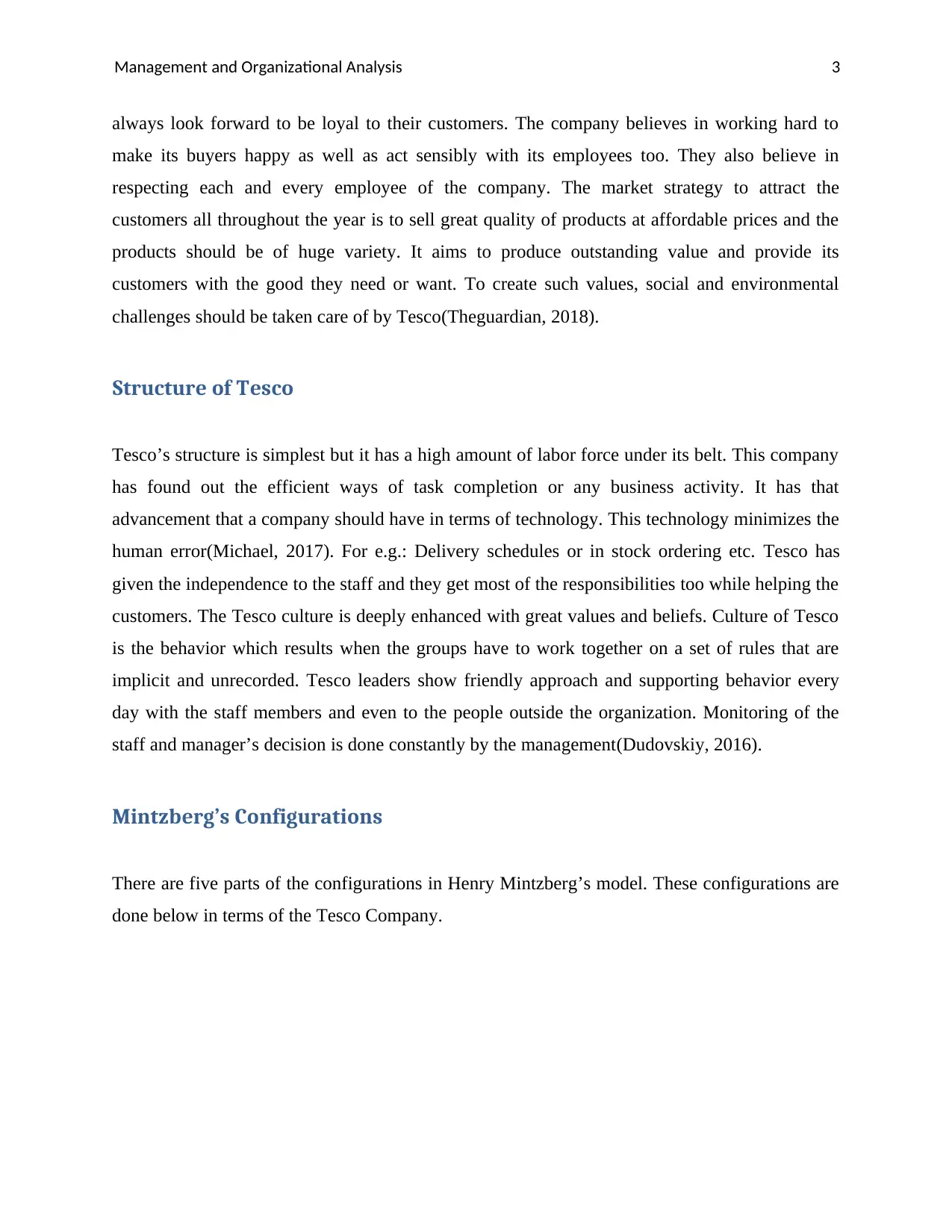
Management and Organizational Analysis 3
always look forward to be loyal to their customers. The company believes in working hard to
make its buyers happy as well as act sensibly with its employees too. They also believe in
respecting each and every employee of the company. The market strategy to attract the
customers all throughout the year is to sell great quality of products at affordable prices and the
products should be of huge variety. It aims to produce outstanding value and provide its
customers with the good they need or want. To create such values, social and environmental
challenges should be taken care of by Tesco(Theguardian, 2018).
Structure of Tesco
Tesco’s structure is simplest but it has a high amount of labor force under its belt. This company
has found out the efficient ways of task completion or any business activity. It has that
advancement that a company should have in terms of technology. This technology minimizes the
human error(Michael, 2017). For e.g.: Delivery schedules or in stock ordering etc. Tesco has
given the independence to the staff and they get most of the responsibilities too while helping the
customers. The Tesco culture is deeply enhanced with great values and beliefs. Culture of Tesco
is the behavior which results when the groups have to work together on a set of rules that are
implicit and unrecorded. Tesco leaders show friendly approach and supporting behavior every
day with the staff members and even to the people outside the organization. Monitoring of the
staff and manager’s decision is done constantly by the management(Dudovskiy, 2016).
Mintzberg’s Configurations
There are five parts of the configurations in Henry Mintzberg’s model. These configurations are
done below in terms of the Tesco Company.
always look forward to be loyal to their customers. The company believes in working hard to
make its buyers happy as well as act sensibly with its employees too. They also believe in
respecting each and every employee of the company. The market strategy to attract the
customers all throughout the year is to sell great quality of products at affordable prices and the
products should be of huge variety. It aims to produce outstanding value and provide its
customers with the good they need or want. To create such values, social and environmental
challenges should be taken care of by Tesco(Theguardian, 2018).
Structure of Tesco
Tesco’s structure is simplest but it has a high amount of labor force under its belt. This company
has found out the efficient ways of task completion or any business activity. It has that
advancement that a company should have in terms of technology. This technology minimizes the
human error(Michael, 2017). For e.g.: Delivery schedules or in stock ordering etc. Tesco has
given the independence to the staff and they get most of the responsibilities too while helping the
customers. The Tesco culture is deeply enhanced with great values and beliefs. Culture of Tesco
is the behavior which results when the groups have to work together on a set of rules that are
implicit and unrecorded. Tesco leaders show friendly approach and supporting behavior every
day with the staff members and even to the people outside the organization. Monitoring of the
staff and manager’s decision is done constantly by the management(Dudovskiy, 2016).
Mintzberg’s Configurations
There are five parts of the configurations in Henry Mintzberg’s model. These configurations are
done below in terms of the Tesco Company.
Paraphrase This Document
Need a fresh take? Get an instant paraphrase of this document with our AI Paraphraser
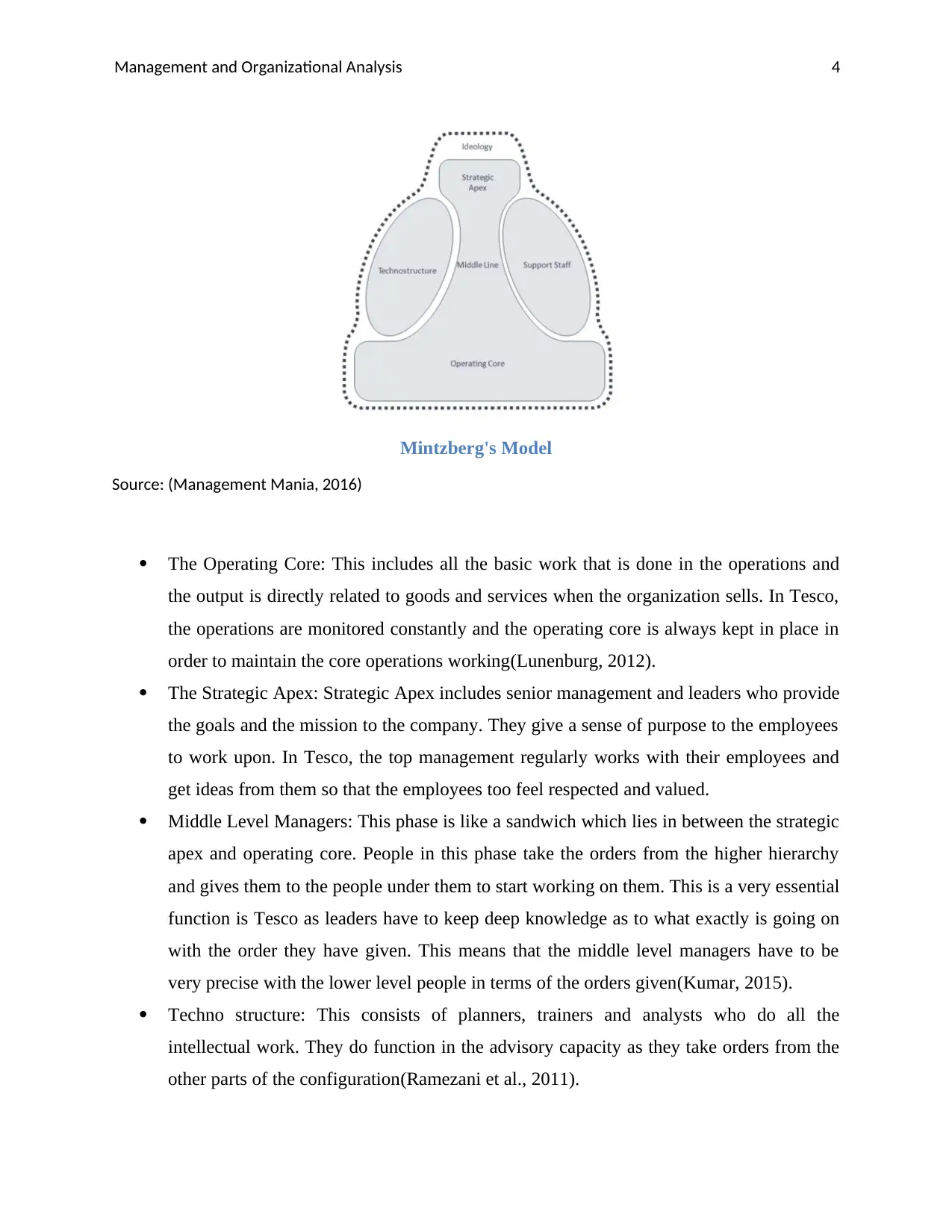
Management and Organizational Analysis 4
Mintzberg's Model
Source: (Management Mania, 2016)
The Operating Core: This includes all the basic work that is done in the operations and
the output is directly related to goods and services when the organization sells. In Tesco,
the operations are monitored constantly and the operating core is always kept in place in
order to maintain the core operations working(Lunenburg, 2012).
The Strategic Apex: Strategic Apex includes senior management and leaders who provide
the goals and the mission to the company. They give a sense of purpose to the employees
to work upon. In Tesco, the top management regularly works with their employees and
get ideas from them so that the employees too feel respected and valued.
Middle Level Managers: This phase is like a sandwich which lies in between the strategic
apex and operating core. People in this phase take the orders from the higher hierarchy
and gives them to the people under them to start working on them. This is a very essential
function is Tesco as leaders have to keep deep knowledge as to what exactly is going on
with the order they have given. This means that the middle level managers have to be
very precise with the lower level people in terms of the orders given(Kumar, 2015).
Techno structure: This consists of planners, trainers and analysts who do all the
intellectual work. They do function in the advisory capacity as they take orders from the
other parts of the configuration(Ramezani et al., 2011).
Mintzberg's Model
Source: (Management Mania, 2016)
The Operating Core: This includes all the basic work that is done in the operations and
the output is directly related to goods and services when the organization sells. In Tesco,
the operations are monitored constantly and the operating core is always kept in place in
order to maintain the core operations working(Lunenburg, 2012).
The Strategic Apex: Strategic Apex includes senior management and leaders who provide
the goals and the mission to the company. They give a sense of purpose to the employees
to work upon. In Tesco, the top management regularly works with their employees and
get ideas from them so that the employees too feel respected and valued.
Middle Level Managers: This phase is like a sandwich which lies in between the strategic
apex and operating core. People in this phase take the orders from the higher hierarchy
and gives them to the people under them to start working on them. This is a very essential
function is Tesco as leaders have to keep deep knowledge as to what exactly is going on
with the order they have given. This means that the middle level managers have to be
very precise with the lower level people in terms of the orders given(Kumar, 2015).
Techno structure: This consists of planners, trainers and analysts who do all the
intellectual work. They do function in the advisory capacity as they take orders from the
other parts of the configuration(Ramezani et al., 2011).
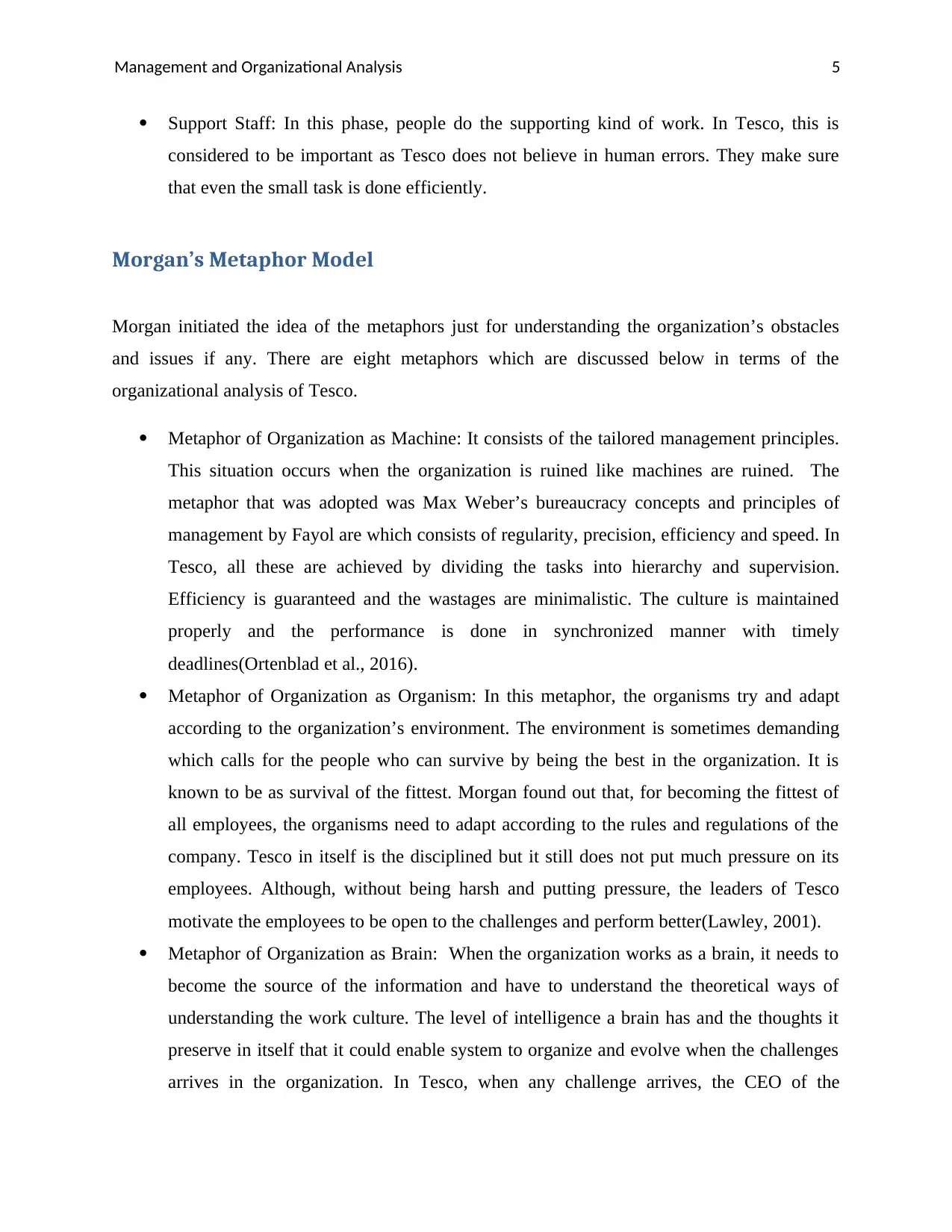
Management and Organizational Analysis 5
Support Staff: In this phase, people do the supporting kind of work. In Tesco, this is
considered to be important as Tesco does not believe in human errors. They make sure
that even the small task is done efficiently.
Morgan’s Metaphor Model
Morgan initiated the idea of the metaphors just for understanding the organization’s obstacles
and issues if any. There are eight metaphors which are discussed below in terms of the
organizational analysis of Tesco.
Metaphor of Organization as Machine: It consists of the tailored management principles.
This situation occurs when the organization is ruined like machines are ruined. The
metaphor that was adopted was Max Weber’s bureaucracy concepts and principles of
management by Fayol are which consists of regularity, precision, efficiency and speed. In
Tesco, all these are achieved by dividing the tasks into hierarchy and supervision.
Efficiency is guaranteed and the wastages are minimalistic. The culture is maintained
properly and the performance is done in synchronized manner with timely
deadlines(Ortenblad et al., 2016).
Metaphor of Organization as Organism: In this metaphor, the organisms try and adapt
according to the organization’s environment. The environment is sometimes demanding
which calls for the people who can survive by being the best in the organization. It is
known to be as survival of the fittest. Morgan found out that, for becoming the fittest of
all employees, the organisms need to adapt according to the rules and regulations of the
company. Tesco in itself is the disciplined but it still does not put much pressure on its
employees. Although, without being harsh and putting pressure, the leaders of Tesco
motivate the employees to be open to the challenges and perform better(Lawley, 2001).
Metaphor of Organization as Brain: When the organization works as a brain, it needs to
become the source of the information and have to understand the theoretical ways of
understanding the work culture. The level of intelligence a brain has and the thoughts it
preserve in itself that it could enable system to organize and evolve when the challenges
arrives in the organization. In Tesco, when any challenge arrives, the CEO of the
Support Staff: In this phase, people do the supporting kind of work. In Tesco, this is
considered to be important as Tesco does not believe in human errors. They make sure
that even the small task is done efficiently.
Morgan’s Metaphor Model
Morgan initiated the idea of the metaphors just for understanding the organization’s obstacles
and issues if any. There are eight metaphors which are discussed below in terms of the
organizational analysis of Tesco.
Metaphor of Organization as Machine: It consists of the tailored management principles.
This situation occurs when the organization is ruined like machines are ruined. The
metaphor that was adopted was Max Weber’s bureaucracy concepts and principles of
management by Fayol are which consists of regularity, precision, efficiency and speed. In
Tesco, all these are achieved by dividing the tasks into hierarchy and supervision.
Efficiency is guaranteed and the wastages are minimalistic. The culture is maintained
properly and the performance is done in synchronized manner with timely
deadlines(Ortenblad et al., 2016).
Metaphor of Organization as Organism: In this metaphor, the organisms try and adapt
according to the organization’s environment. The environment is sometimes demanding
which calls for the people who can survive by being the best in the organization. It is
known to be as survival of the fittest. Morgan found out that, for becoming the fittest of
all employees, the organisms need to adapt according to the rules and regulations of the
company. Tesco in itself is the disciplined but it still does not put much pressure on its
employees. Although, without being harsh and putting pressure, the leaders of Tesco
motivate the employees to be open to the challenges and perform better(Lawley, 2001).
Metaphor of Organization as Brain: When the organization works as a brain, it needs to
become the source of the information and have to understand the theoretical ways of
understanding the work culture. The level of intelligence a brain has and the thoughts it
preserve in itself that it could enable system to organize and evolve when the challenges
arrives in the organization. In Tesco, when any challenge arrives, the CEO of the
⊘ This is a preview!⊘
Do you want full access?
Subscribe today to unlock all pages.

Trusted by 1+ million students worldwide
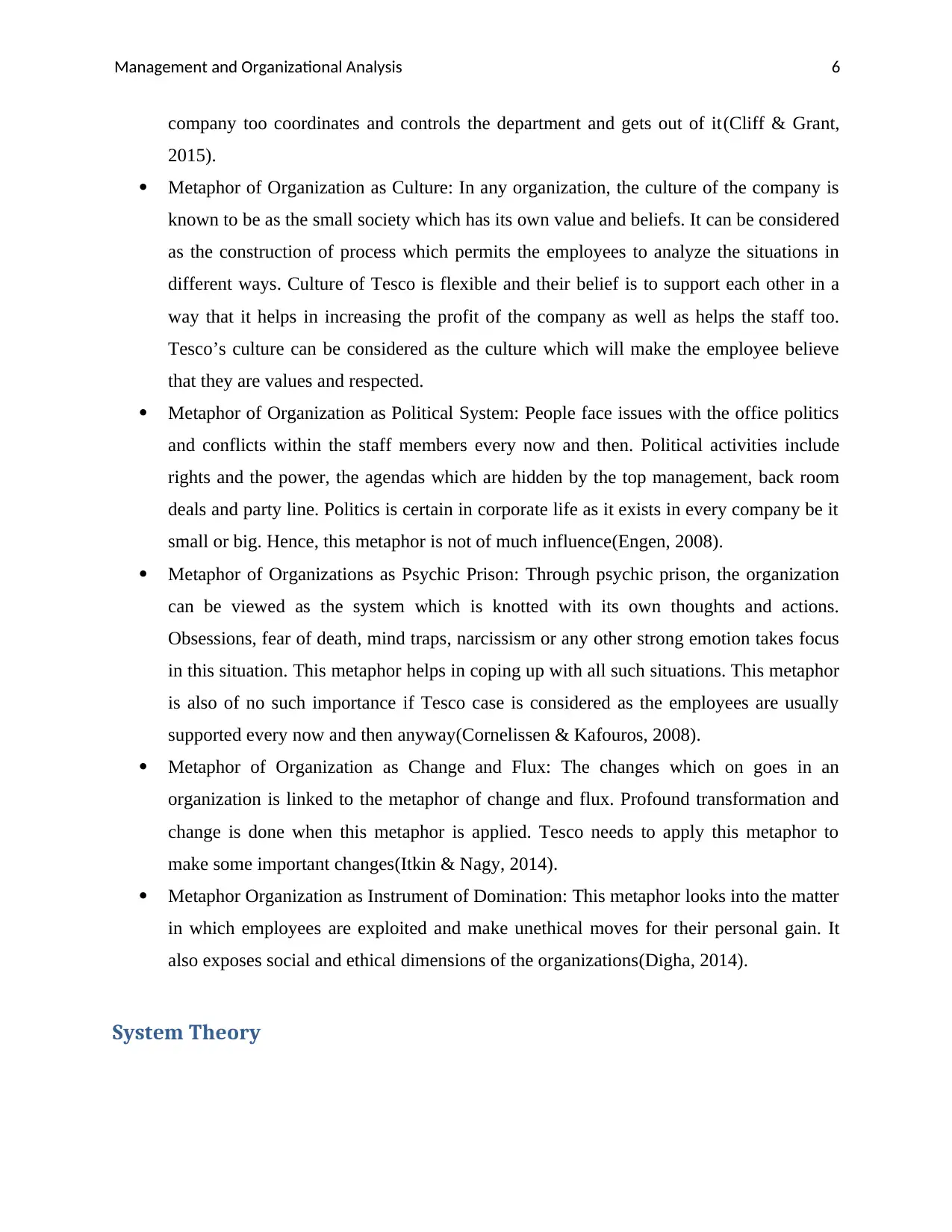
Management and Organizational Analysis 6
company too coordinates and controls the department and gets out of it(Cliff & Grant,
2015).
Metaphor of Organization as Culture: In any organization, the culture of the company is
known to be as the small society which has its own value and beliefs. It can be considered
as the construction of process which permits the employees to analyze the situations in
different ways. Culture of Tesco is flexible and their belief is to support each other in a
way that it helps in increasing the profit of the company as well as helps the staff too.
Tesco’s culture can be considered as the culture which will make the employee believe
that they are values and respected.
Metaphor of Organization as Political System: People face issues with the office politics
and conflicts within the staff members every now and then. Political activities include
rights and the power, the agendas which are hidden by the top management, back room
deals and party line. Politics is certain in corporate life as it exists in every company be it
small or big. Hence, this metaphor is not of much influence(Engen, 2008).
Metaphor of Organizations as Psychic Prison: Through psychic prison, the organization
can be viewed as the system which is knotted with its own thoughts and actions.
Obsessions, fear of death, mind traps, narcissism or any other strong emotion takes focus
in this situation. This metaphor helps in coping up with all such situations. This metaphor
is also of no such importance if Tesco case is considered as the employees are usually
supported every now and then anyway(Cornelissen & Kafouros, 2008).
Metaphor of Organization as Change and Flux: The changes which on goes in an
organization is linked to the metaphor of change and flux. Profound transformation and
change is done when this metaphor is applied. Tesco needs to apply this metaphor to
make some important changes(Itkin & Nagy, 2014).
Metaphor Organization as Instrument of Domination: This metaphor looks into the matter
in which employees are exploited and make unethical moves for their personal gain. It
also exposes social and ethical dimensions of the organizations(Digha, 2014).
System Theory
company too coordinates and controls the department and gets out of it(Cliff & Grant,
2015).
Metaphor of Organization as Culture: In any organization, the culture of the company is
known to be as the small society which has its own value and beliefs. It can be considered
as the construction of process which permits the employees to analyze the situations in
different ways. Culture of Tesco is flexible and their belief is to support each other in a
way that it helps in increasing the profit of the company as well as helps the staff too.
Tesco’s culture can be considered as the culture which will make the employee believe
that they are values and respected.
Metaphor of Organization as Political System: People face issues with the office politics
and conflicts within the staff members every now and then. Political activities include
rights and the power, the agendas which are hidden by the top management, back room
deals and party line. Politics is certain in corporate life as it exists in every company be it
small or big. Hence, this metaphor is not of much influence(Engen, 2008).
Metaphor of Organizations as Psychic Prison: Through psychic prison, the organization
can be viewed as the system which is knotted with its own thoughts and actions.
Obsessions, fear of death, mind traps, narcissism or any other strong emotion takes focus
in this situation. This metaphor helps in coping up with all such situations. This metaphor
is also of no such importance if Tesco case is considered as the employees are usually
supported every now and then anyway(Cornelissen & Kafouros, 2008).
Metaphor of Organization as Change and Flux: The changes which on goes in an
organization is linked to the metaphor of change and flux. Profound transformation and
change is done when this metaphor is applied. Tesco needs to apply this metaphor to
make some important changes(Itkin & Nagy, 2014).
Metaphor Organization as Instrument of Domination: This metaphor looks into the matter
in which employees are exploited and make unethical moves for their personal gain. It
also exposes social and ethical dimensions of the organizations(Digha, 2014).
System Theory
Paraphrase This Document
Need a fresh take? Get an instant paraphrase of this document with our AI Paraphraser
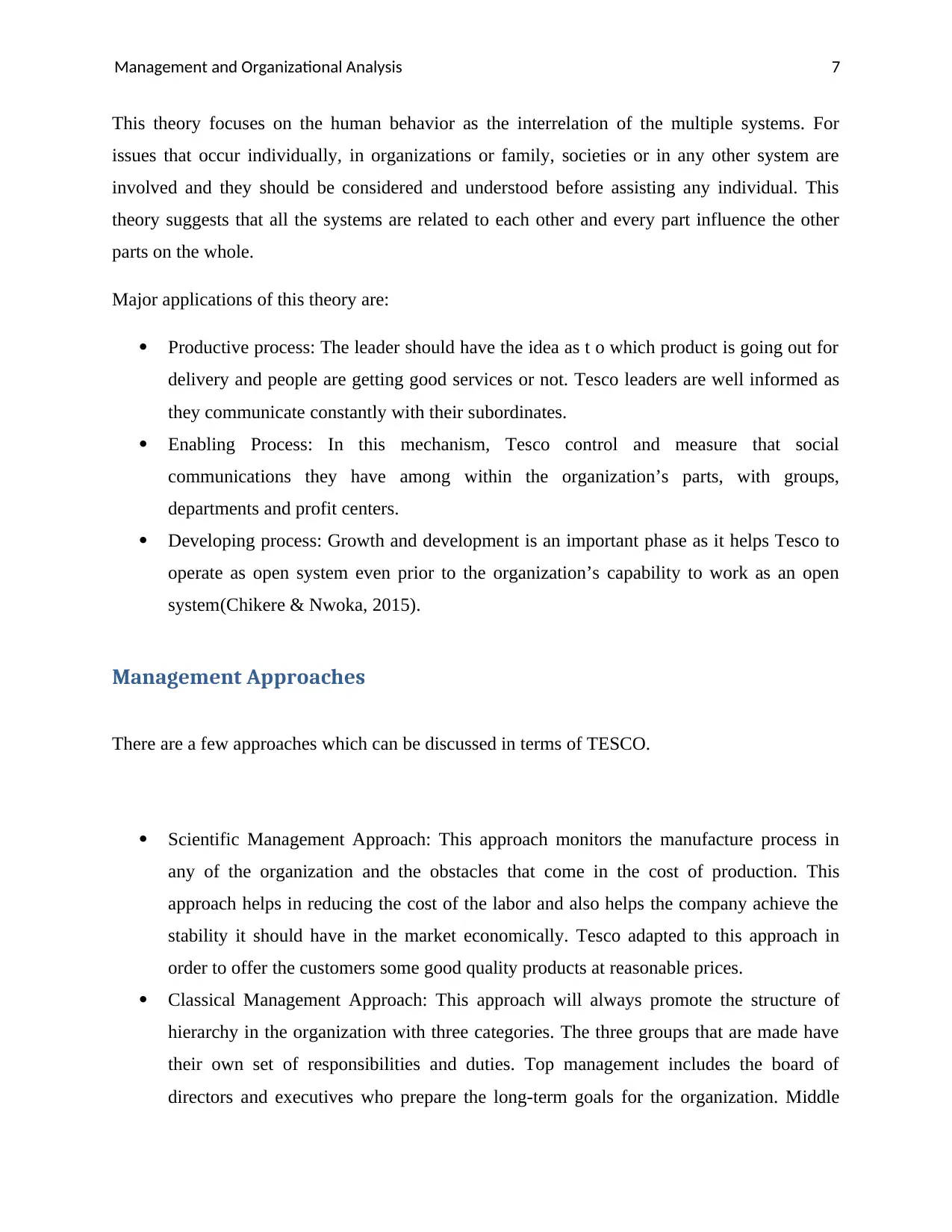
Management and Organizational Analysis 7
This theory focuses on the human behavior as the interrelation of the multiple systems. For
issues that occur individually, in organizations or family, societies or in any other system are
involved and they should be considered and understood before assisting any individual. This
theory suggests that all the systems are related to each other and every part influence the other
parts on the whole.
Major applications of this theory are:
Productive process: The leader should have the idea as t o which product is going out for
delivery and people are getting good services or not. Tesco leaders are well informed as
they communicate constantly with their subordinates.
Enabling Process: In this mechanism, Tesco control and measure that social
communications they have among within the organization’s parts, with groups,
departments and profit centers.
Developing process: Growth and development is an important phase as it helps Tesco to
operate as open system even prior to the organization’s capability to work as an open
system(Chikere & Nwoka, 2015).
Management Approaches
There are a few approaches which can be discussed in terms of TESCO.
Scientific Management Approach: This approach monitors the manufacture process in
any of the organization and the obstacles that come in the cost of production. This
approach helps in reducing the cost of the labor and also helps the company achieve the
stability it should have in the market economically. Tesco adapted to this approach in
order to offer the customers some good quality products at reasonable prices.
Classical Management Approach: This approach will always promote the structure of
hierarchy in the organization with three categories. The three groups that are made have
their own set of responsibilities and duties. Top management includes the board of
directors and executives who prepare the long-term goals for the organization. Middle
This theory focuses on the human behavior as the interrelation of the multiple systems. For
issues that occur individually, in organizations or family, societies or in any other system are
involved and they should be considered and understood before assisting any individual. This
theory suggests that all the systems are related to each other and every part influence the other
parts on the whole.
Major applications of this theory are:
Productive process: The leader should have the idea as t o which product is going out for
delivery and people are getting good services or not. Tesco leaders are well informed as
they communicate constantly with their subordinates.
Enabling Process: In this mechanism, Tesco control and measure that social
communications they have among within the organization’s parts, with groups,
departments and profit centers.
Developing process: Growth and development is an important phase as it helps Tesco to
operate as open system even prior to the organization’s capability to work as an open
system(Chikere & Nwoka, 2015).
Management Approaches
There are a few approaches which can be discussed in terms of TESCO.
Scientific Management Approach: This approach monitors the manufacture process in
any of the organization and the obstacles that come in the cost of production. This
approach helps in reducing the cost of the labor and also helps the company achieve the
stability it should have in the market economically. Tesco adapted to this approach in
order to offer the customers some good quality products at reasonable prices.
Classical Management Approach: This approach will always promote the structure of
hierarchy in the organization with three categories. The three groups that are made have
their own set of responsibilities and duties. Top management includes the board of
directors and executives who prepare the long-term goals for the organization. Middle
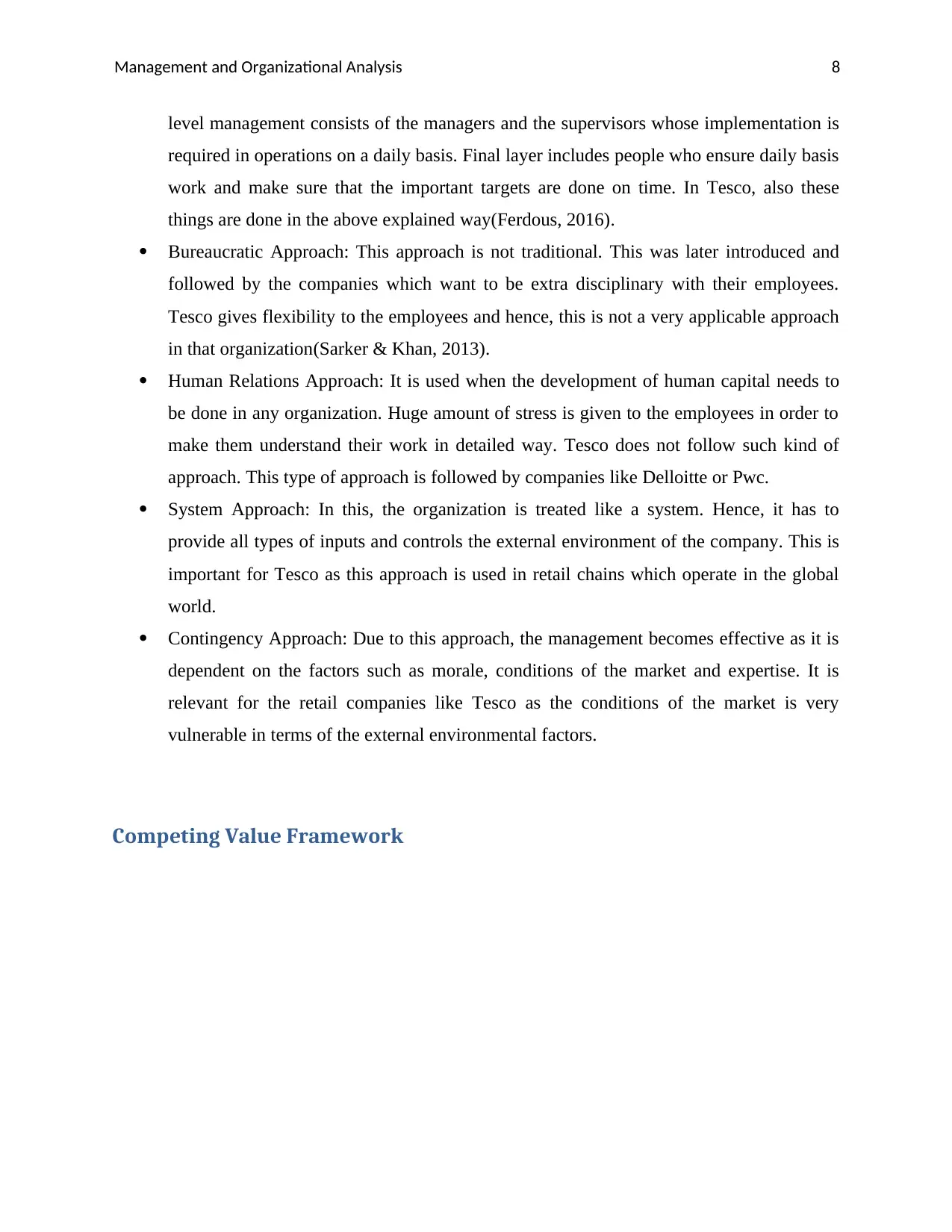
Management and Organizational Analysis 8
level management consists of the managers and the supervisors whose implementation is
required in operations on a daily basis. Final layer includes people who ensure daily basis
work and make sure that the important targets are done on time. In Tesco, also these
things are done in the above explained way(Ferdous, 2016).
Bureaucratic Approach: This approach is not traditional. This was later introduced and
followed by the companies which want to be extra disciplinary with their employees.
Tesco gives flexibility to the employees and hence, this is not a very applicable approach
in that organization(Sarker & Khan, 2013).
Human Relations Approach: It is used when the development of human capital needs to
be done in any organization. Huge amount of stress is given to the employees in order to
make them understand their work in detailed way. Tesco does not follow such kind of
approach. This type of approach is followed by companies like Delloitte or Pwc.
System Approach: In this, the organization is treated like a system. Hence, it has to
provide all types of inputs and controls the external environment of the company. This is
important for Tesco as this approach is used in retail chains which operate in the global
world.
Contingency Approach: Due to this approach, the management becomes effective as it is
dependent on the factors such as morale, conditions of the market and expertise. It is
relevant for the retail companies like Tesco as the conditions of the market is very
vulnerable in terms of the external environmental factors.
Competing Value Framework
level management consists of the managers and the supervisors whose implementation is
required in operations on a daily basis. Final layer includes people who ensure daily basis
work and make sure that the important targets are done on time. In Tesco, also these
things are done in the above explained way(Ferdous, 2016).
Bureaucratic Approach: This approach is not traditional. This was later introduced and
followed by the companies which want to be extra disciplinary with their employees.
Tesco gives flexibility to the employees and hence, this is not a very applicable approach
in that organization(Sarker & Khan, 2013).
Human Relations Approach: It is used when the development of human capital needs to
be done in any organization. Huge amount of stress is given to the employees in order to
make them understand their work in detailed way. Tesco does not follow such kind of
approach. This type of approach is followed by companies like Delloitte or Pwc.
System Approach: In this, the organization is treated like a system. Hence, it has to
provide all types of inputs and controls the external environment of the company. This is
important for Tesco as this approach is used in retail chains which operate in the global
world.
Contingency Approach: Due to this approach, the management becomes effective as it is
dependent on the factors such as morale, conditions of the market and expertise. It is
relevant for the retail companies like Tesco as the conditions of the market is very
vulnerable in terms of the external environmental factors.
Competing Value Framework
⊘ This is a preview!⊘
Do you want full access?
Subscribe today to unlock all pages.

Trusted by 1+ million students worldwide
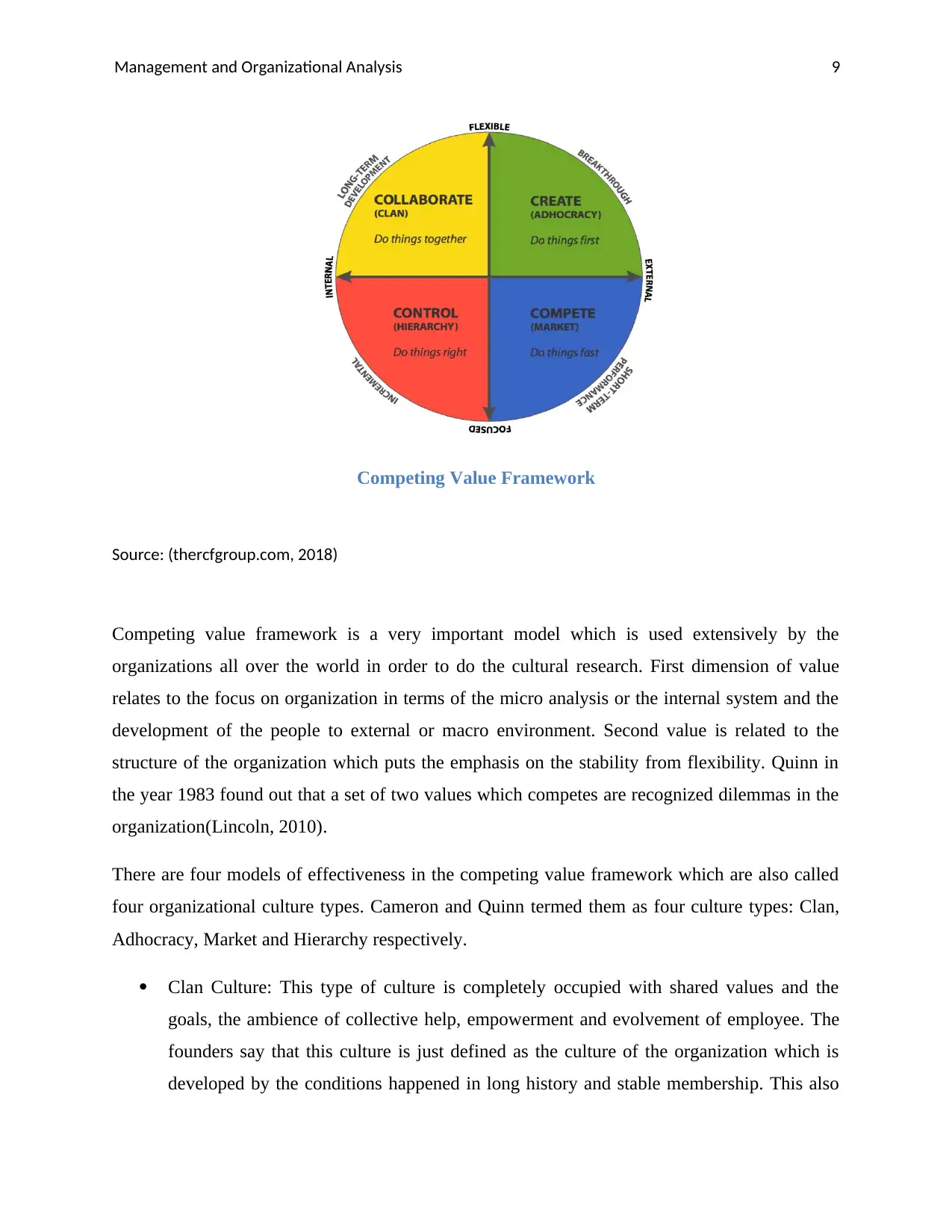
Management and Organizational Analysis 9
Competing Value Framework
Source: (thercfgroup.com, 2018)
Competing value framework is a very important model which is used extensively by the
organizations all over the world in order to do the cultural research. First dimension of value
relates to the focus on organization in terms of the micro analysis or the internal system and the
development of the people to external or macro environment. Second value is related to the
structure of the organization which puts the emphasis on the stability from flexibility. Quinn in
the year 1983 found out that a set of two values which competes are recognized dilemmas in the
organization(Lincoln, 2010).
There are four models of effectiveness in the competing value framework which are also called
four organizational culture types. Cameron and Quinn termed them as four culture types: Clan,
Adhocracy, Market and Hierarchy respectively.
Clan Culture: This type of culture is completely occupied with shared values and the
goals, the ambience of collective help, empowerment and evolvement of employee. The
founders say that this culture is just defined as the culture of the organization which is
developed by the conditions happened in long history and stable membership. This also
Competing Value Framework
Source: (thercfgroup.com, 2018)
Competing value framework is a very important model which is used extensively by the
organizations all over the world in order to do the cultural research. First dimension of value
relates to the focus on organization in terms of the micro analysis or the internal system and the
development of the people to external or macro environment. Second value is related to the
structure of the organization which puts the emphasis on the stability from flexibility. Quinn in
the year 1983 found out that a set of two values which competes are recognized dilemmas in the
organization(Lincoln, 2010).
There are four models of effectiveness in the competing value framework which are also called
four organizational culture types. Cameron and Quinn termed them as four culture types: Clan,
Adhocracy, Market and Hierarchy respectively.
Clan Culture: This type of culture is completely occupied with shared values and the
goals, the ambience of collective help, empowerment and evolvement of employee. The
founders say that this culture is just defined as the culture of the organization which is
developed by the conditions happened in long history and stable membership. This also
Paraphrase This Document
Need a fresh take? Get an instant paraphrase of this document with our AI Paraphraser

Management and Organizational Analysis
10
can develop in the absence of institutional alternatives and huge interactions with the
members. Tesco also believes in empowering of their employees.
Adhocracy Culture: This is a kind of temporary institution which can be rejected when
the tasks in the organization are ended and refilled when different tasks emerge. This type
of culture is found in a few industries like filming, space flight, consulting and IT
etc(Botti & Vesci, 2018).
Market Culture: Market culture will always focus on the environments in which
transactions happen outside of the organization rather than internal organization. The goal
of the company is to earn profits with the help of the competition that occurs in market.
This was founded by Ouchi with the study of market control system.
Hierarchy Culture: In this type, the structure of the organization is very clear. It had
certain standardized policies and procedures and control. This can be taken as the image
of bureaucracy as defined by Weber in the study of modern organizational management
(Yu & Wu , 2009).
Managing Across Cultures
The culture of the organization can be studied by Hofstede’s Theory of Cultural Dimensions.
Hofstede’s model provides an outline for studying various features of human behavior across
different cultures.
Power Distance: This dimension defines the structure of the company and the attitude for power.
These can be distinguished between two patterns: firms which have clear structure and
distinctions in those who manage the firm and those who are managed by them. And firms in
which flat structure is there where people are more or less equal in designation. It describes
degree with which people accept any one of those two patterns. People, who have larger degrees,
feel easy and comfortable in the hierarchy. People with low power distance wish for equality at
work(Hofstede, 2011).
10
can develop in the absence of institutional alternatives and huge interactions with the
members. Tesco also believes in empowering of their employees.
Adhocracy Culture: This is a kind of temporary institution which can be rejected when
the tasks in the organization are ended and refilled when different tasks emerge. This type
of culture is found in a few industries like filming, space flight, consulting and IT
etc(Botti & Vesci, 2018).
Market Culture: Market culture will always focus on the environments in which
transactions happen outside of the organization rather than internal organization. The goal
of the company is to earn profits with the help of the competition that occurs in market.
This was founded by Ouchi with the study of market control system.
Hierarchy Culture: In this type, the structure of the organization is very clear. It had
certain standardized policies and procedures and control. This can be taken as the image
of bureaucracy as defined by Weber in the study of modern organizational management
(Yu & Wu , 2009).
Managing Across Cultures
The culture of the organization can be studied by Hofstede’s Theory of Cultural Dimensions.
Hofstede’s model provides an outline for studying various features of human behavior across
different cultures.
Power Distance: This dimension defines the structure of the company and the attitude for power.
These can be distinguished between two patterns: firms which have clear structure and
distinctions in those who manage the firm and those who are managed by them. And firms in
which flat structure is there where people are more or less equal in designation. It describes
degree with which people accept any one of those two patterns. People, who have larger degrees,
feel easy and comfortable in the hierarchy. People with low power distance wish for equality at
work(Hofstede, 2011).

Management and Organizational Analysis
11
Individualism: This dimension helps the determining whether people use “I” or “We” in while
talking. Those who prefer “I” are will be responsible for their own welfare. Those who use “We”
will take help from their relatives and burden them.
Uncertainty Avoidance: Degree of risk acceptance is defined by this dimension. If the degree of
uncertainty is high then future is also uncertain. If low then it means free ideas are accepted.
Long-Term V/s Short Term Orientation: It is always reflected in the attitude of the thinker who is
normative. Short term gives results quickly and long term focuses more on the savings and
investment(Rinuastuti et al., 2014).
Tesco uses external recruitment. This results in the competition between the managers about
being potential recruits. The competencies needed in Tesco are universal and this is demanded
by many other organizations. Hence, in some of the situations, it is unethical to use Hofstede’s
model in recruitment in Tesco. Tesco is a good retailer with broad expansion in its food as they
offer wide range of products.
Senge’s Five Disciplines
When any change is happening, Tesco must involve internal and external stakeholders. Peter
Senge’s theory is used for self-checkout machines in Tesco. The theory is explained in five
points:
System Thinking: As a complete organization, Tesco needs to think about it being a system.
Blaming should not be done to others rather Tesco should see how it operates and what is going
wrong. System should be hunted for it. System thinking sort of helps in observing the whole
process in the organization. Sometimes, small things are overlooked by managers. System
thinking enables the managers to see those problems and resolve it(Coto, 2012).
Personal Mastery: This is related to the motivation and to people who are very committed to their
work. Self-motivation should exist in them to achieve change they are looking for. Personal
mastery occurs when a person has clear goals with having the perception of the reality. Creative
vision if the company will have, people will also have clear vision(Zeeman, 2018).
11
Individualism: This dimension helps the determining whether people use “I” or “We” in while
talking. Those who prefer “I” are will be responsible for their own welfare. Those who use “We”
will take help from their relatives and burden them.
Uncertainty Avoidance: Degree of risk acceptance is defined by this dimension. If the degree of
uncertainty is high then future is also uncertain. If low then it means free ideas are accepted.
Long-Term V/s Short Term Orientation: It is always reflected in the attitude of the thinker who is
normative. Short term gives results quickly and long term focuses more on the savings and
investment(Rinuastuti et al., 2014).
Tesco uses external recruitment. This results in the competition between the managers about
being potential recruits. The competencies needed in Tesco are universal and this is demanded
by many other organizations. Hence, in some of the situations, it is unethical to use Hofstede’s
model in recruitment in Tesco. Tesco is a good retailer with broad expansion in its food as they
offer wide range of products.
Senge’s Five Disciplines
When any change is happening, Tesco must involve internal and external stakeholders. Peter
Senge’s theory is used for self-checkout machines in Tesco. The theory is explained in five
points:
System Thinking: As a complete organization, Tesco needs to think about it being a system.
Blaming should not be done to others rather Tesco should see how it operates and what is going
wrong. System should be hunted for it. System thinking sort of helps in observing the whole
process in the organization. Sometimes, small things are overlooked by managers. System
thinking enables the managers to see those problems and resolve it(Coto, 2012).
Personal Mastery: This is related to the motivation and to people who are very committed to their
work. Self-motivation should exist in them to achieve change they are looking for. Personal
mastery occurs when a person has clear goals with having the perception of the reality. Creative
vision if the company will have, people will also have clear vision(Zeeman, 2018).
⊘ This is a preview!⊘
Do you want full access?
Subscribe today to unlock all pages.

Trusted by 1+ million students worldwide
1 out of 30
Related Documents
Your All-in-One AI-Powered Toolkit for Academic Success.
+13062052269
info@desklib.com
Available 24*7 on WhatsApp / Email
![[object Object]](/_next/static/media/star-bottom.7253800d.svg)
Unlock your academic potential
Copyright © 2020–2025 A2Z Services. All Rights Reserved. Developed and managed by ZUCOL.





